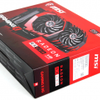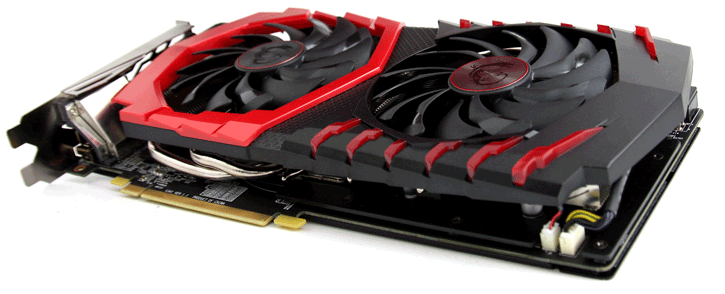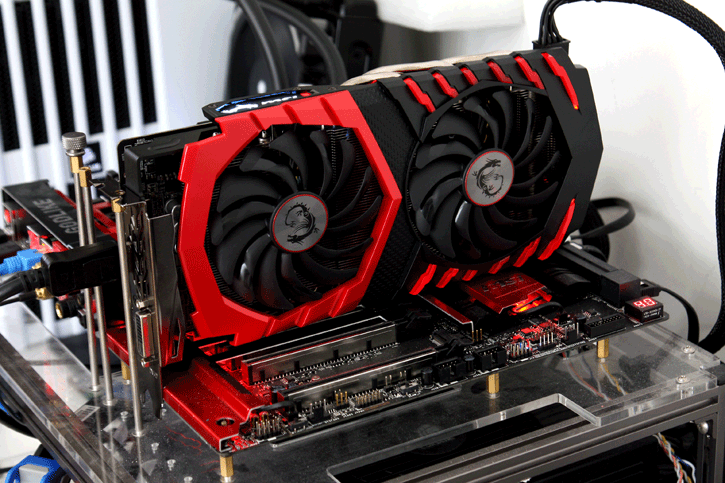Final words and conclusion
Final words and conclusion
The RX 480 is a product series with super sex-appeal, the reference product however IMHO was a tad too noisy and ran a tad to hot. Next to that we all disliked the 6-pin power connector as it's just really close to the 150 Watt TDP. The board partners improved on everything the reference product did half-half. As such this gaming X model has a proper cooler, is silent, has an 8-pin power connector, comes with a back-plate and is a notch tweaked out of the box as well. The end result is a massively impressive product series. What remains important though is that the price level will remain hovering at comfortable levels. Expect a 269 USD price-tag for this 8GB version, and yes MSI will release a 4 GB version as well. his GPU with GDDR5 memory at 8 Gbps offers plenty of horsepower but also does that at just over 150 Watt power-consumption, and for this kind of game performance that remains lovely.
Aesthetics
The new Gaming X series come with the stylish TwinFrozr VI cooler looks serious. The 2016 update also comes with RGB LED lighting control as well as a LED array in the rear surrounding the fan. The top logo etc you can switch on/off or to any color and animation you prefer, the choice is yours. Cool dibs is that back-plate, with opening at the proper areas (GPU/VRM) for venting. As you can see, I remain skeptical about backplates, they potentially can trap heat and thus warm up the PCB. But the flip-side is that they do look better and can protect your PCB and components from damage. Consumer demand is always decisive, and you guys clearly like graphics cards with backplates. Both the front IO plate and backplate are dark matte black which certainly gives the card that premium feel. In the the end result is a lovely looking product however a warning to MSI, the Twinfrozr series is slowly becoming a little repetitive with the black red design.
Performance
Performance wise you just cannot be anything other than thrilled about the Radeon RX 480. Now, the card is a bit all over the place; extremely fast in fill-rate limited games, a little less with GPU stringent ones but overall you are looking at a product that competes with the GeForce GTX 970 and sometimes even 980. What was baffling to see though is that this 8GB model is often spot on in performance with the Radeon R9 390 series and thus R9 290 series as well. And that actually might be a problem. See, many of you are already in the 390 or Fury series and seen from that product perspective, the RX 480 will offer nothing new other than a few features. However, as we rewind that to where you are on a 280/280X/280 series graphics card, well, for 199 or 229 USD you are in for a treat in terms of performance and value. Let's not forget about other features; the Radeon RX 480 and Polaris 10 overall will offer proper performance, Eyefinity features and PCIe gen 3 compatibility and all the other stuff like HDMI 2.0b, DisplayPort 1.4 with HDR support and so on. The Radeon RX 480 series is a proper DirectX 12 product right from the get-go and has that little extra bite thanks to an increased number of shader processors (2304).
Who Would The Radeon RX 480 8GB Be Best Suited For?
As always, the answer to that question is a little complex. I would say that you'll need to look at your monitor and game preferences first and foremost. This card at its given price range makes quite a lot of sense right now for 1080P and 1440P. It is a very capable 2560x1440 resolution gaming graphics card and it obviously makes for a truly excellent 1080P card as well. Especially at that monitor resolution the card makes so much sense. But granted, at WQHD (2560x1440) most games run well enough. Another benefit is that at least the most elementary and arbitrary DirectX 12 Feature levels are supported in hardware. Even on very harsh-on-the-GPU titles you'll refrain from un-ticking graphics quality options to gain on framerate performance, there's very little trade-off to be made as the RX 480 will deliver enough. In short, for the money this is an excellent 1080P and a proper 1440P card that will often offer a nice 40~60 FPS experience at WQHD and proper image quality settings. It has plenty of muscle and has the graphics memory to deal with it, even with the best quality settings and some niche AA levels. Resolutions after 2560x1440 will be more complicated. Price to performance wise one should also take Crossfire into consideration. However, with multi-GPUs also comes 0-day driver issues with game releases. We'll test it at some point but two Radeon RX 480 cards set up in Crossfire might be a very sweet solution for Ultra HD gamers or the ones who like to go a little nasty with VSR and, of course, the latest gaming titles. Performance wise, most games will run seriously well at the very best image quality settings at 2560x1440. And sure, the cool factor remains that you get the advantages of an 8 GB framebuffer (if you opt for that model). With 8GB we feel the card is rather future proof as well.
Pricing
Value wise the Radeon RX 480 is simply making a lot more sense compared to anything the market currently offers. I think anyone will agree with me on that. Nvidia has been driving the prices upwards, and, being a bit of an underdog, AMD traditionally always tries to offer that little extra value wise. Typically the high-end class product hovers at the 500 USD marker. Nvidia, when they released it, drove the GTX 970 to 399 USD and the GTX 980 to 549 USD. The Radeon RX 480 as tested today in the Gaming X version will be a 269 USD product with roughly similar prices in the EU. However low availability has risen prices upwards. My advice, buy at the right moment and do not overpay.
Cooling and Noise levels
The Gaming X model comes factory tweaked at a notch over 1300 MHz. The temperature seems to hover at roughly 73 Degrees C under full stress. That's a good notch below the reference cooler. The best part is that it is a drop-dead silent card. ANd when I say silent I mean silent, period. The cooler itself works really well, the card however does exhaust part of the warm air inside the PC, the vent at the monitor IO plate is hardly used if at all. The card did not make any coil whine noises.
Power Consumption
The board is rated by us at roughly 150 Watts TDP, that means when you completely stress it, that's the power consumption. Our measurements showed that the board TDP is indeed roughly in that Wattage region, we measured a little higher but with some games also noticed lower wattages. The move to 14nm FiNFET obviously is testimony to a great perf/watt ratio. We feel that at 160~165 Watts the card is consuming very reasonable amounts of power for this kind of performance. No complaints here really.
Overclocking
The card in default mode is running 1304 MHz and that unfortunately means there isn't a lot of room left for tweaking. In the coming weeks you'll be able to OC with AfterBurner as we are working on support for it It'll get you a proper voltage slider, a MHz increase as well as voltage control (offset) and fan control. That's what I want and need, not the endless unneeded nonsense that both teams now have implemented in their drivers. Overclocking wise we could get the card stable at ~1370 MHz. We tried 1400 MHz and while it's booting and working for while, it did not remain stable enough. So 1370 MHz is pushing it. The memory will reach anywhere from 8.8~9.0 Gbps (for the 8 GB model). Overall these are satisfying results. With a default temperature profile the card will remain to be silent and at the very same temperature levels as default.
Final Words
The number of MSI Gaming series graphics cards we have tested lately is immense, so immense that we take for granted how good the cooling and design really is. MSI took the RX 480 GPU and improved on the design with a proper cooler, proper OC mode and added a back-plate to it. Also huge props for the inclusion of a DVI connector. Anyone looking for an affordable upgrade to a WQHD capable graphics card coming from say a 280/380... well, this card series will offer killah value for money. 269 USD for this version is merely a tenner over reference and that makes this a mainstream product. Other than that, the Radeon RX 480 8GB is obviously a little gem for the serious gamer with a proper monitor as it just oozes value. A nice plus is the relative lower power consumption. We consider the Radeon RX 480 4GB and 8GB to be a first run in the new high-end performance cards. The Polaris 10 architecture seems very sound and proves it can deliver big-time whilst remaining in line power consumption wise, we do think it is merely a small iteration over GCN Generation 3, the die-shrink with 14nm FinFET is the biggest benefit in terms of relative performance and wattage. Heat and noise wise I'd like to declare the product as a truly and nicely custom cooled AIB product. The Gaming X overall is a proper Full HD and even WQHD gaming graphics cards with all the right boxes ticked. Highly recommended if you have a nice mid-range graphics card in your purchasing short list.
Recommended Downloads
- Sign up to receive a notice when we publish a new article
- Or go back to Guru3D's front page




